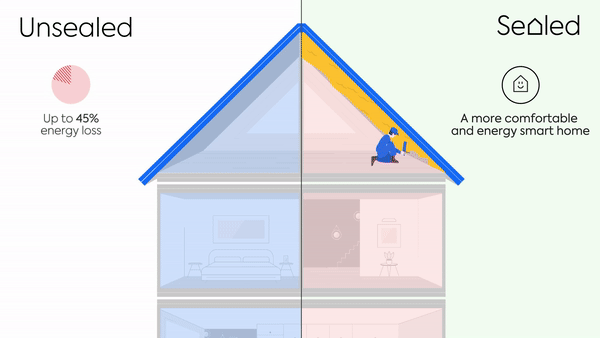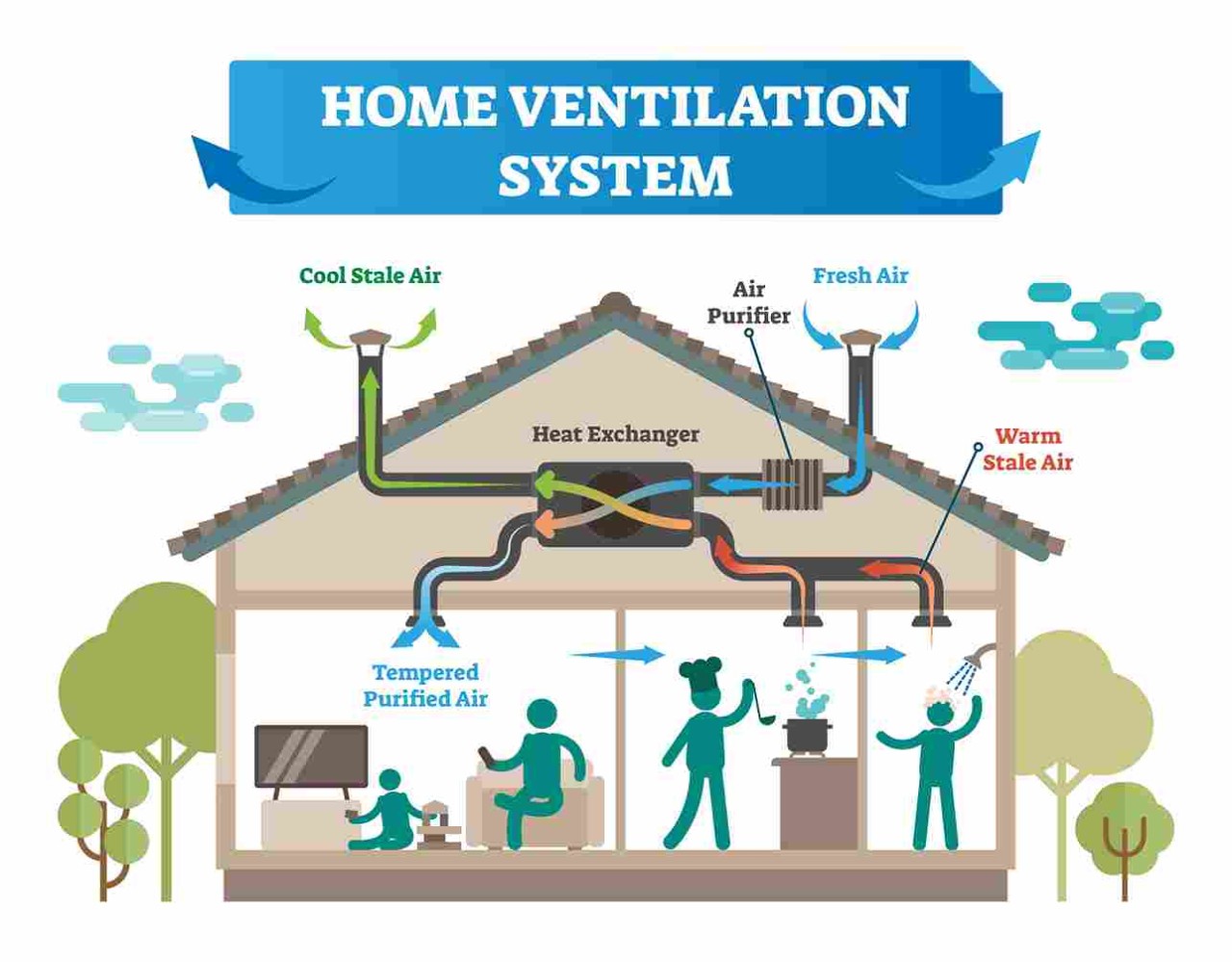Checking Out Ingenious Solutions for Ideal Home Ventilation Equipments
Home air flow plays an essential role in maintaining health and comfort within living rooms. With improvements in technology, cutting-edge solutions are emerging to maximize these systems. Smart ventilation, energy recovery ventilators, and advanced filtering are reshaping exactly how air top quality is handled - Home Ventilation Melbourne. Nevertheless, the combination of these modern technologies raises questions concerning their performance and versatility in varied home environments. What implications do these advancements hold for future living criteria?
The Importance of Home Ventilation for Health and Comfort
Although often neglected, home ventilation plays a vital duty in keeping both wellness and convenience within domestic areas. Adequate air flow is essential for the circulation of fresh air, which aids to weaken indoor pollutants such as volatile natural substances, irritants, and smells. Without correct airflow, these pollutants can build up, resulting in respiratory concerns and other health issue. Additionally, effective ventilation adds to controling humidity degrees, stopping mold development and structural damages. By making certain a well balanced exchange of air, locals can delight in a more pleasant indoor environment, enhancing overall well-being. Furthermore, ample air flow can enhance energy effectiveness by minimizing the requirement for extreme heating or cooling, inevitably leading to reduced utility costs and a much more lasting living room.
Smart Air Flow Solutions: Harnessing Modern Technology for Effectiveness
Smart air flow systems represent a substantial improvement in home air monitoring, leveraging IoT combination for improved control. These systems not only advertise power performance yet additionally offer remote tracking capabilities, enabling individuals to maximize their indoor atmospheres flawlessly. By harnessing innovation, property owners can achieve enhanced air quality while lowering power intake.
IoT Combination Advantages
How can IoT combination transform typical ventilation systems into highly efficient clever solutions? By incorporating Web of Points (IoT) technology, ventilation systems can accomplish real-time monitoring and control, improving their functional performance. Sensors put throughout a home collect information on air humidity, quality, and temperature level, permitting automated modifications based on current problems. This instant responsiveness brings about enhanced interior air top quality and convenience degrees. Furthermore, IoT-enabled systems can interact with various other smart home devices, creating a cohesive community that optimizes power usage. Customers can also accessibility and handle their ventilation systems from another location via mobile phones, supplying comfort and increased control. Generally, IoT assimilation stands for a significant innovation, bringing intelligence and adaptability to conventional ventilation methods.
Power Efficiency Features
As power efficiency ends up being an essential emphasis in contemporary home design, progressed air flow systems offer ingenious attributes that significantly lower power usage. These smart air flow systems use sensors to monitor indoor air humidity, temperature, and top quality levels, immediately changing airflow to maintain perfect conditions. By utilizing power recovery ventilators (ERVs), they catch and reuse energy from outward bound air, minimizing heating and cooling down needs. Variable rate followers even more enhance efficiency by readjusting their procedure based upon real-time demands, preventing unnecessary energy waste - Home Ventilation Melbourne. Furthermore, programmable timers and occupancy sensing units assure that air flow operates only when needed, adding to reduced utility expenses. Jointly, these attributes represent a considerable advancement in creating energy-efficient and lasting living environments
Remote Surveillance Capabilities
What benefits do remote surveillance abilities bring to modern home air flow systems? These abilities permit house owners to track interior air high quality and system performance in real time, improving general performance. By providing data on air, humidity, and temperature toxins, clever ventilation systems enable proactive adjustments, guaranteeing suitable problems. On top of that, remote tracking facilitates maintenance notifies, identifying prospective problems before they rise, thereby reducing repair work costs and downtime. Users can access system analytics through mobile applications, enabling hassle-free control also when far from home. This technological combination not just promotes power efficiency yet likewise adds to a healthier living environment. Eventually, remote monitoring capacities represent a significant advancement in home air flow, lining up with the expanding demand for wise home technologies.
Power Recuperation Ventilators: Making The Most Of Power Financial Savings
Energy recovery ventilators (ERVs) play an important function in improving home energy efficiency via effective warm exchange. By moving thermal power in between outbound and inbound air, these systems significantly lower general power usage. This cutting-edge approach not only maintains indoor air quality however also contributes to reduce utility expenses.
Performance of Warm Exchange
While keeping indoor air top quality is important for wellness and comfort, the efficiency of heat exchange in power healing ventilators (ERVs) plays a vital duty in making the most of energy financial savings. The main function of an ERV is to transfer warmth and moisture in between outgoing and incoming air streams, which optimizes indoor problems while decreasing power loss. High-efficiency warm exchangers can substantially minimize the tons on heating and cooling systems by reclaiming power that would certainly or else be thrown away. The performance of these systems is frequently determined by their core temperature exchange rates, which site link can vary based on style and products used. By concentrating on innovative heat exchange innovations, homeowners can boost their air flow systems, resulting in improved energy efficiency and cost reductions over time.
Minimized Power Usage
Minimizing power intake is a crucial benefit of power recuperation ventilators (ERVs), as they efficiently recycle thermal power from worn down air. By transferring heat between incoming and outward bound jet stream, ERVs decrease the requirement for additional heating or air conditioning, leading to considerable energy financial savings. This procedure not just reduces energy expenses but likewise minimizes the ecological effect connected with greater energy use. Additionally, ERVs keep consistent indoor air high quality without compromising thermal comfort, developing a balanced living atmosphere. By incorporating ERVs into home ventilation systems, homeowners can accomplish greater energy efficiency, allowing a lasting method to interior air administration while profiting from reduced energy bills. Ultimately, ERVs stand for an engaging remedy for energy-conscious consumers.
Advanced Filtering Technologies for Cleanser Indoor Air
As interior air high quality comes to be increasingly recognized as a crucial part of health and wellness and well-being, advanced filtering technologies are emerging as important devices for ensuring cleaner settings. These technologies include high-efficiency particulate air (HEPA) filters, turned on carbon filters, and electrostatic precipitators, each created to properly capture airborne toxins, allergens, and unpredictable natural substances (VOCs) HEPA filters can trap particles as tiny as 0.3 microns, greatly reducing allergens like dirt termites and animal dander. Activated carbon filters succeed in adsorbing smells and chemical vapors, adding to a fresher indoor ambience. Furthermore, electrostatic precipitators utilize electric costs to remove bits, giving an energy-efficient option. By incorporating these advanced filtration systems, property owners can improve indoor air top quality and advertise healthier home.
The Role of Sensing Units in Maximizing Airflow and Top Quality
Exactly how can sensing units change the monitoring of indoor air high quality? Sensing units play a vital function in improving air movement and improving indoor environments. By continually checking aspects such as humidity, temperature level, and degrees of contaminants, they offer real-time information that notifies ventilation systems. This information enables automated modifications to air flow, making certain ample circulation and lessening the buildup of pollutants. In addition, progressed sensing units can find specific air top quality concerns, prompting immediate reactions to boost comfort and wellness. The assimilation of these gadgets right into air flow systems enables a much more responsive and reliable administration strategy, decreasing power usage while keeping optimal air quality. Inevitably, sensors work as a crucial component in developing healthier interior rooms with specific air movement guideline.
Integrating Air Flow With Smart Home Solutions
While several home owners seek benefit and efficiency, incorporating ventilation systems with clever home innovation supplies an ingenious solution to handling interior air top quality. By linking air flow units to wise home centers, locals can automate air quality monitoring and control air flow based on real-time information. These systems can react to modifications in temperature level, humidity, and contaminant degrees, making sure excellent interior problems. Smart thermostats can operate in tandem with ventilation systems to improve energy performance, reducing costs while maintaining convenience. Property owners can likewise from another location manage their ventilation settings through mobile apps, supplying versatility and tranquility of mind. Ultimately, this integration not only simplifies management but considerably enhances the general living environment, making it an important addition to modern-day homes.
Future Patterns in Home Ventilation Solutions
Arising innovations and increased awareness of interior air top quality are shaping the future of home ventilation remedies. One substantial pattern is the integration of expert system, making it possible for systems to adjust air movement based on real-time data and occupancy patterns. Furthermore, power recuperation ventilators are obtaining grip, offering efficient air exchange while decreasing power loss. Making use of green products and styles is likewise on the rise, straightening with sustainability anonymous objectives. Smart sensing units that keep track of contaminants and humidity levels are becoming criterion, permitting property owners to preserve suitable indoor environments. Furthermore, scalable and modular systems are arising, supplying adjustable alternatives for different home dimensions and setups. Home Ventilation Melbourne. With each other, these advancements promise to boost convenience, effectiveness, and health in domestic spaces
Regularly Asked Concerns
How Usually Should I Clean My Home Ventilation System?

The regularity of cleaning up a home ventilation system differs based on use and setting. Normally, it is suggested to clean the system every three to six months to keep ideal air high quality and system effectiveness.
Can Poor Air Flow Cause Mold Development Indoors?

What Are the Indications of Inadequate Home Ventilation?
Indications of inadequate home ventilation consist of consistent smells, boosted humidity levels, condensation on home windows, visible mold growth, and a general sensation visit of stodginess. These indicators often suggest that air circulation wants for preserving a healthy indoor setting.
How Can I Enhance Air Flow in Older Houses?
To enhance ventilation in older homes, one may think about setting up exhaust followers, using natural airflow through home windows, securing voids for much better air control, and including air cleansers to improve interior air high quality properly.
Are Do It Yourself Ventilation Solutions Effective and Safe?

Smart ventilation, energy recovery ventilators, and progressed filtration are reshaping how air top quality is taken care of. As power effectiveness ends up being an essential emphasis in modern-day home style, advanced ventilation systems offer innovative features that significantly decrease energy consumption. By integrating ERVs into home air flow systems, home owners can attain better power performance, making it possible for a lasting method to indoor air monitoring while benefiting from lower energy costs. The integration of these gadgets right into ventilation systems enables for a much more efficient and responsive monitoring strategy, minimizing power usage while preserving excellent air top quality. While numerous homeowners look for benefit and efficiency, incorporating ventilation systems with wise home modern technology offers a cutting-edge option to managing interior air quality.